Balenciaga
See it »
<span>Too many young American designers fail to deliver the kind of haute-casual comfort that's become a staple of the restaurant world.</span>
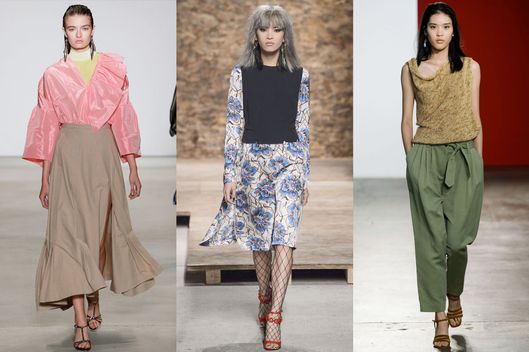

Nothing competes with the elemental on a hot night in New York. After the Tome show on Thursday, I hiked it across Houston Street to Prune, where I chased charred short ribs and two glasses of Pinot with the rare offering of summer pudding. I was taking my first bite of the bread and fruit when a guy and a girl walked in.
They were tall and good-looking, near 40; she had long brown hair and a strong face, he a full beard and close-set eyes that blinked a lot. She wore a stained white cotton shirt with painter’s pants and moccasins; he was in black. Both wore hats — his, a baseball cap, hers a large fedora. In the spirit of Gabrielle Hamilton’s book, Blood, Bone & Butter, I was in warm company, among strangers, and these two self-confident-looking people in hats, along with the tart taste of the pudding, made me think about the day.
I had seen three fairly similar shows: Tome, Creatures of the Wind, and Creatures of Comfort. Not similar in style perhaps; Shane Gabier and Christopher Peters of Creatures of the Wind show more tailoring, as well as mixtures of fabric and vintagelike texture. Jade Lai, of the other Creatures, does very soft and unconstructed clothes with a vague air of travel. Ramon Martin and Ryan Lobo of Tome like airy skirts and refashioned white cotton shirts garnished with a sort of half-ruffle.
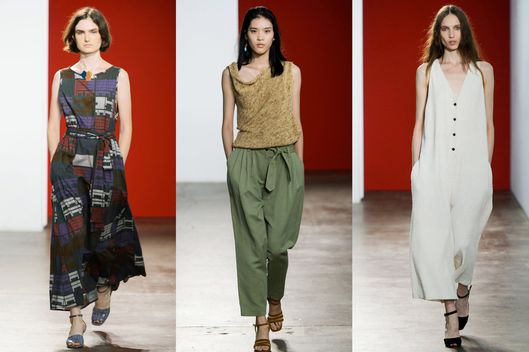
But all three of these collections revealed designers struggling to innovate, and in the case of Lai, trying to inflate her extremely modest efforts with highfalutin references, like Corbusier’s architecture. She showed some nice summer clothes in faded prints, earthy colors, and oversize shapes. But everything about Lai’s presentation — the agonizingly slow couture pacing of the models, their carefully messy hair, the white-box space — seemed artificial. In contrast with the clothes, which would do better in a showroom, accompanied by the creaturely comforts of tea and real human warmth.
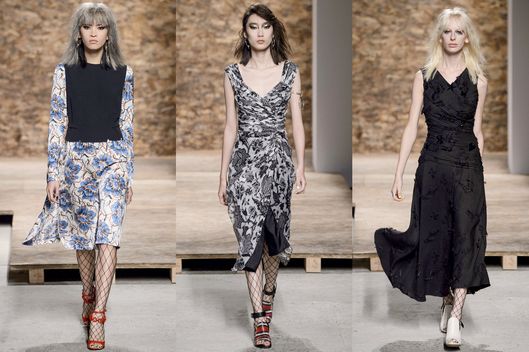
The New York shows tend to make fleeting moments seem more significant than they are, and this is perhaps most evident in the first few days of Fashion Week. I loved some of the dresses at Creatures of the Wind; I’m a sucker for printed charmeuse that spills over the body and ends in a trumpet-y flourish. I also appreciate that the designers need to eat. But in securing a more grown-up look for their once-offbeat label, Gabier and Peters have become one more brand known mainly for quirkiness — not for boldness or surprise. There’s a danger in doing these funky mixes of fabrics and trims: Someone like Dries Van Noten already does them in greater depth and at less cost.
The great thing about the recent designs of, say, Nicolas Ghesquière and Raf Simons is that they are within the bounds of everyday human experience, although they are hardly casual. They’re not theatrical, nor are they loaded with pointless design effects. New York designers rely too heavily on these gestures, as if to cover up a mediocre design.
Why can’t New York fashion deliver a perfect summer pudding? I’m not going to attempt to answer that question here, but I do think it has a lot to do with a lack of self-confidence among young designers, and plain old integrity. There’s a lot of pressure on new designers to be “different” or “creative,” but many of them simply don’t have that gene. They certainly don’t have vision. So we get piles of clothes with weird gestures, pushed along by unwarranted hype. I keep saying to myself, "What’s wrong with the equivalent of bread and fruit? It’s satisfying, it’s familiar but somehow unexpected, and it’s honest."
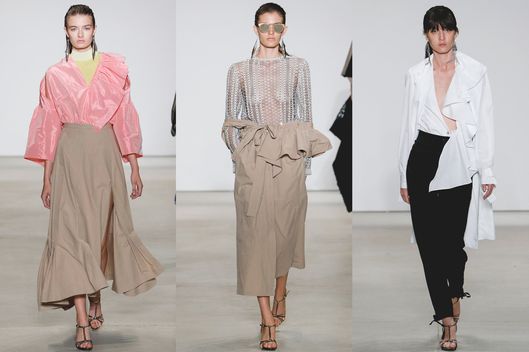
I have to say I admire the spirit of Martin and Lobo at Tome. You can tell they like the design process because there’s a sense of play in their work. But that’s also the trouble with too many of their spring clothes: They look self-consciously playful and challenging. What they needed was more refining
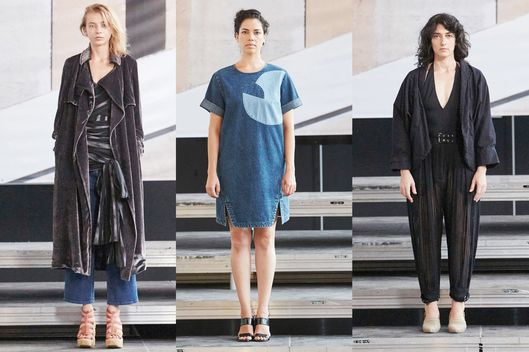
Rachel Comey showed on Wednesday night, putting on her regular dinner in Red Hook. This was not the strongest Comey collection; too many wilting shapes. But Comey has more integrity than a lot of designers; she has quietly and steadily cultivated a following, and she generally knows how to make a design sing without mangling it. She has been innovative with denim — without the effort showing. In fact, a woman like Comey could go much further as a designer if she had the resources of a big company around her — design teams, fabric people, fast sample rooms. A company should be thinking about investing in her menu. She has the ideas and, more, the backbone.
To be fair, it was a 13 foot-long dress.
You and Rihanna Will Both Want to Invest in Dior’s New BagIt's got something for everyone.
Polo Shirts Have Turned Their Back on Ryan LochteAlong with his other major sponsors.
Ryan Lochte Will No Longer Be Paid to Wear Tiny Bathing SuitsSpeedo remains committed to transparency.
Laura Brown Is the New Editor-in-Chief of InStyleAfter 11 years at Harper’s Bazaar.
Tyra Banks Is Going to Teach a Class on Smizing at Stanford"If I see somebody not paying attention, I’m gonna call on them."
This Floating Pier Is the Most Zen Installation EverWalking on water in Italy.
Nation Is Appalled by Matt Lauer’s Nude Ankles During Ryan Lochte InterviewWhat’s the opposite of “Jeah”?
8 People at the Life of Pablo Pop-up Explain Why Kanye West Is a God"I mean, Kanye West is just Kanye West. There's not more or less you can say about Kanye West. He's just Mr. West!"
A T-shirt Is EnoughSimplicity, versatility, and cool. What more could you want?
She took a perfect pencil dive off a 30-foot yacht.
American Apparel Is Being Sued by Former WorkersAs the company considers putting itself up for sale.
A Gendered History of the Tailored SuitFrom Marlon Brando to Coco Chanel.
How Zendaya Developed Such Great Style at the Young Age of 19The star's best looks from Disney to now.
Proof That If You’re Chic Enough, a Little Federal Investigation Doesn’t MatterIs this the best they could do?
5,300-Year-Old Mummified Iceman Probably Would’ve Been a Street-Style StarHe had several different looks and was “pretty picky.”
J.Crew Has Identified 226 Shades of PinkEven more than there are shades of gray.
Gigi and Bella Hadid Merch Is Now Somehow a Thing That Is HappeningToday in Hadidiana.
Gird Your Loins for the Return of Yeezy to New York Fashion WeekThe season approaches.
This Indie Brand Had a Great Response to Ivanka TrumpWhen she bought one of their cuffs, they donated the proceeds to the Clinton campaign.